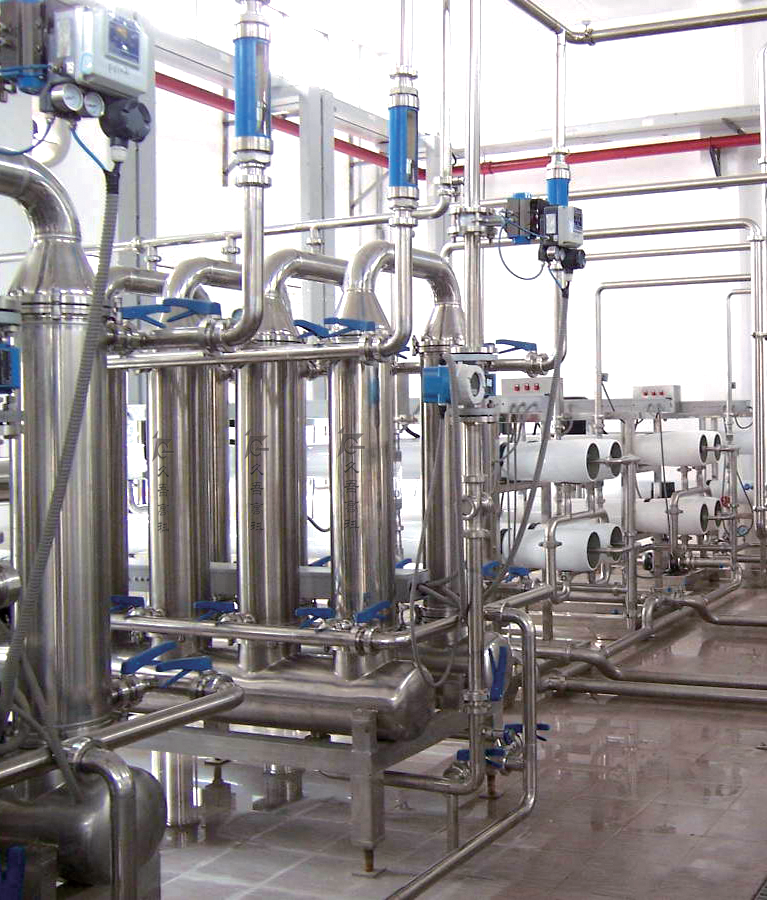1.The Principle of Inorganic Ceramic Membrane Technology
Ceramic membrane is one kind of inorganic membrane, belongs to the solid membrane material in membrane separation technology, mainly with different specifications of alumina, zirconium oxide, titanium oxide and silicon oxide and other inorganic ceramic materials as a support body, and is produced through the surface coating, and high-temperature firing. Ceramic membrane tube wall is densely covered with micropores, under pressure, the raw material liquid in the membrane tube or flow outside the membrane, small molecule material (or liquid) through the membrane, large molecule material (or solid) is retained by the membrane, so as to achieve the separation, concentration, purification and environmental protection purposes, it is a "cross-flow filtration" form of fluid separation process.
2.Details about Inorganic Ceramic Membrane Technology
2.1 Types of Filtering
Ceramic membrane can be divided into microfiltration (aperture greater than 50nm), ultrafiltration (aperture 2 ~ 50nm), nanofiltration (aperture less than 2nm) and other types according to the pore size. When separating, under the action of external force, small molecules material through the membrane, large molecules material is retained by the membrane, so as to achieve the separation, concentration, purification, impurity removal, sterilization and other purposes.
2.2 Characteristics of Inorganic Ceramic Membrane Filtering
(1).At room temperature: effectively reduce component loss, especially for heat-sensitive substances.
(2). No phase change: maintain the original flavor, very low energy consumption, the cost is about 3/1-8/1 of evaporation concentration.
(3). No chemical change: typical physical separation process, no chemical reagents and additives, no pollution of the product.
(4). Good selectivity: can be separated at the molecular level, with universal filter media can not be replaced by excellent performance.
(5). Strong applicability: the scale of treatment can be large or small, can be continuous or intermittent, simple process, convenient operation, easy to automate.
3.Application of Inorganic Ceramic Membrane in Edible oil Wastewater
Vegetable oil plants generate a certain amount of industrial wastewater during the production and processing of oils and fats, mainly including cooking wastewater from the leaching plant, washing wastewater from the refining plant, and process wastewater from the condenser of the steam injection unit, as well as a certain amount of cleaning wastewater. The grease wastewater is produced in the vegetable oil refining process. The wastewater from grease washing is complex, mainly containing meal, neutral grease, fatty acid salts in the form of soap, organic phosphorus in the form of phospholipids, inorganic phosphorus in the form of phosphoric acid, dissolved inorganic acids, alkalis, salt, pigments and other substances. High oil content and high CODCr (chemical oxygen demand), direct discharge will cause serious pollution of water bodies.
The inorganic ceramic membrane separation technology is firstly to pretreat the alkali refining and washing wastewater from the refining workshop with a two-stage oil separation treatment, and then use the inorganic ceramic membrane separation system device to pretreat the wastewater so that the fatty substances in the wastewater can be concentrated and separated from the water to recover the final concentrated liquid. Then the effluent (permeate) from the inorganic ceramic membrane separation system device is pumped into the regulating pond, and under anaerobic conditions, the large molecules of difficult to degrade organic pollutants contained in the wastewater are transformed into small molecules of easily degradable organic pollutants by using hydrolysis acidification microorganisms, and then treated by biological contact oxidation unit to ensure that the quality of the effluent completely meets the emission standards.
The use of inorganic ceramic membrane separation technology for grease wastewater treatment, not only can improve the resource utilization rate of recyclable materials in the wastewater and further reduce the operating costs of wastewater treatment facilities; at the same time, the permeate CODCr is greatly reduced after separation, which improves the ability of the hydrolytic acidification microorganisms in the wastewater to transform large organic pollutants into small molecules of easily degradable organic pollutants, and then through biological contact oxidation unit treatment, the effluent quality would fully meet the discharge standard. The treated wastewater will be discharged into the sewage treatment plant of the Development Zone through the sewage network for centralized treatment.
The inorganic ceramic membrane separation equipment can run stably for a long time, can not only make the wastewater meet the standard, but also reuse the produced water, at the same time, it can also recover the oil contained in the wastewater, solving the problem of wastewater treatment while improving the utilization of resources.
4.Conclusion
Responding to the challenges and growing demands of the rapidly growing water treatment industry, vegetable oil plants are relying on expertise for better resource management and water conservation. The application of inorganic ceramic membrane separation technology in the field of vegetable oil wastewater is a green, economical and efficient water treatment technology that meets clean development and international environmental standards.






 +86-25-58849045
+86-25-58849045
 +86-25-58749295
+86-25-58749295
 jiuwu@jiuwu.com
jiuwu@jiuwu.com
 No. 9 Park Road, Pukou District, Nanjing City (Sanqiao Factory)
No. 9 Park Road, Pukou District, Nanjing City (Sanqiao Factory) Call us on:
Call us on:  Email Us:
Email Us:  No. 9 Park Road, Pukou District, Nanjing City (Sanqiao Factory)
No. 9 Park Road, Pukou District, Nanjing City (Sanqiao Factory)

 English
English 한국어
한국어 français
français русский
русский Español
Español

